What is hot pot?
Chinese hot pot is a popular cooking style that involves everyone cooking their food in a shared pot of broth.
Hot pot is more of an experience than a dish itself. It encapsulates the Chinese’s communal dining ethos when close friends and family members eat together during a slow and interactive meal.
Hot pot is popular during the reunion diner on Chinese New Year eve, offering a heartwarming atmosphere for conversation during the cold winter around the table. Everyone will gather around the simmering pot of broth, poaching their food with a small ladle. That is the time when family members share their experiences and encounters, retold their childhood stories, and enjoy the moments of reunion.
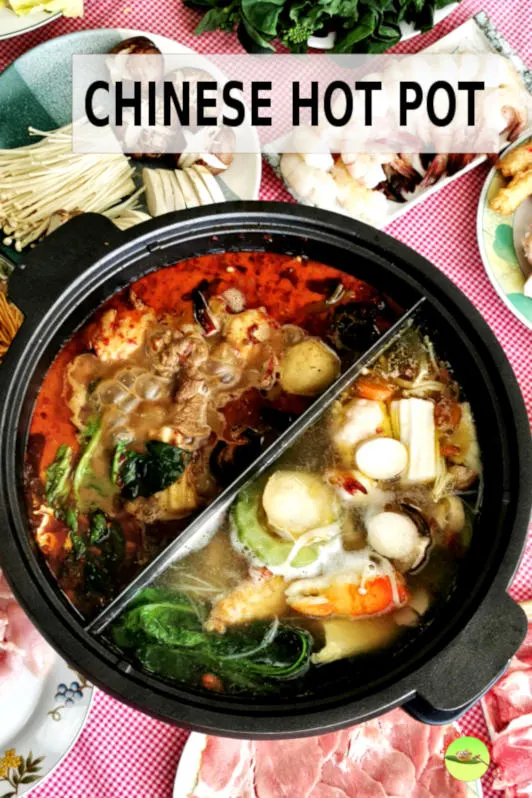
Note: This post may contain affiliate links. Please read my privacy policy for more info. I may receive commissions for purchases made through links in this post. As an Amazon Associate, I earn from qualifying purchases.
Various names of hot pot
There are a few other English names for hot pot. Hot Pot is directly translated from two Chinese words, 火锅, which is pronounced as ‘huoguo.’ Hence, some recipes refer to this dish as “huoguo.” Hot pot is also called steamboat in Southern China and some South East Asia countries. The Cantonese called it 打边炉, loosely translated as ‘cook and eat besides the pot.’
How to make Chinese hot pot
This blog post is relatively long, and I have divided it into sections. You can click the link below to jump to the respective section.
- The various types of Chinese hot pot
- A good stock is the most crucial element of the hot pot soup base
- How to prepare the stock from scratch
- The Szechuan mala hotpot
- The Cantonese style herbal soup base (non-spicy)
- The essential hot pot equipment
- The popular food cooked in the hot pot
- The dipping sauce
- Other related recipes to Chinese hot pot (steamboat)
- The Chinese hot pot recipe
1. The various types of Chinese hot pot
Each restaurant and family make it a little different than the other but can be broadly grouped into a few categories.
- The Cantonese hotpot is a clean broth with plenty of fresh seafood, meat, and vegetables. It emphasizes significantly on the flavor of the broth.
- The Szechuan style hot pot is prepared with a chock-full of mouth-numbing Sichuan peppercorns, red chilies, and many spices.
- The Mongolian hot pot from northern China has lamb as the standard choice, cooked in a clear chicken or lamb broth.
The advent of packaged hot pot soup basis has made it convenient for us to savor different types of hot pot, but it is never the same as to make it from scratch as you have total control of the flavor and the level of spiciness.
2. A good stock is the most crucial element of the hot pot soup base
The foundation of the Chinese hot pot soup base is a good stock. My go-to ingredient is a mixture of chicken and pork bones.
I will explain how to prepare the two most common hot pot soup bases. The first one is the most popular, i.e., the Szechuan style spicy hot pot broth. The second one is the utterly non-spicy version I grew up with, the Cantonese herbal soup base.
Note: You can use the store-bought chicken stock as the alternative, but the flavor is not as good as making it from scratch, especially of the Cantonese herbal broth version that the broth’s taste is the highlight of the hot pot.
3. How to prepare the stock from scratch
Here is my recipe to prepare the soup stock from scratch. I am using half chicken and half pork bones to get the best of both.
- Clean the chicken and pork bones under running water several times. This step removes as much blood and debris on the bone, effectively reducing the amount of scum while boiling the stock.
- Place the bones in a pot of cold water and bring it to a boil. The amount of water should be just enough to submerge all the bones.
- After two to three minutes, discard the dirty water, and wash the bones.
- Place the pork bones in a fresh pot of cold water. Bring it to a boil.
- Cut two stalks of scallion and a few slices of ginger. Cook with the pork bones at barely simmering temperature for two hours. The scallions and ginger will remove the raw smell of the bones.
- Remove any scum floating by using a small wire mesh strainer.
- After two hours, add the chicken bones and simmer for another one hour. It takes a shorter time to extract the chicken bones’ flavor because they are thinner than pork bones.
- Remove the bones. Pour the stock through a wire mesh strainer to remove any small bones and debris.
The stock is now ready for the two hot pot soup bases in the recipe.
Note: I will season the soup base later, and therefore do not add any salt to the stock.
Is it worth it to make the stock at home?
The answer lies in how much effort you are willing to put in to make the hot pot.
I make a large amount of stock (more than in the video for demo) when free and portion it to 500 ml each with the freezer-safe container. It can be stored nearly indefinitely, but it seldom lasts me for more than a month. I use it almost for every dish apart from the hot pot soup base. My cream corn soup, winter melon soup, and hot and sour soup are all based on this chicken and pork stock.
Indeed, you need to weigh between the time spent and the reward. There is a whole range of ready-made stock sold in the supermarket as a substitute.
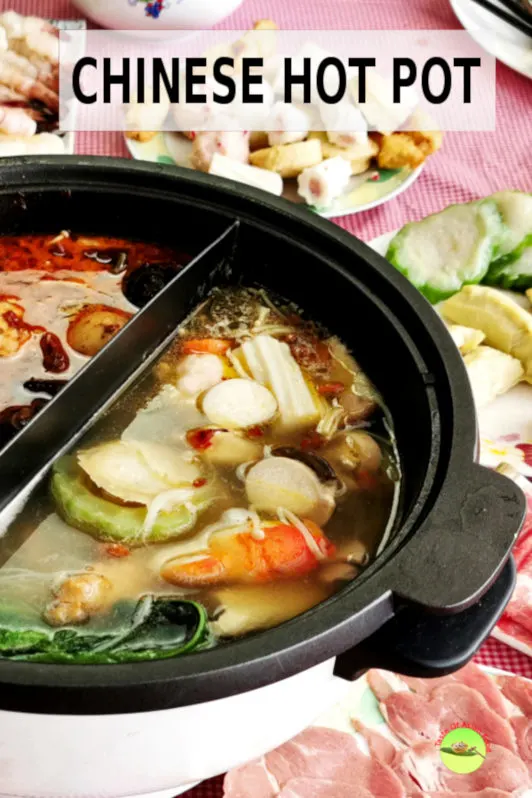
4. The Szechuan mala hotpot
The bright red chili oil floating on top, plus the noticeable red chili, will make anyone feel the heat even not tasting it. The Szechuan peppercorns impart a burst of tongue-numbing feeling called mala 麻辣, which will surely be the most unforgettable experience for the first-timer.
Although every restaurant has a secret recipe, and each household insists they have the best recipe, there are a few shared characteristics in all the countless variations.
- They are fiercely hot, prepared with loads of chilies.
- Szechuan peppercorn is a must, which is the spice that causes the tongue-tingling effect.
- The broth is quite oily, which is common in Szechuan food.
Growing up eating mildly flavored and less oily Cantonese food, I have reduced the spiciness and the amount of oil but retain all other spices to get the authentic flavor.
Here is my version of the Chinese hot pot recipe, Szechuan style.
Preparation
- Cut the dry chilies into 1-inch sections. You have the option to keep or discard the seeds, depending on the level of heat that you prefer.
- Soak the dry chilies with hot water for 30 minutes to soften them so that it is easier to grind them either with a mortar and pestle or an electric blender. Keep the chili paste aside.
- Prepare the spice blend by coarsely ground the spices with the grinder. The spices are star anise, cinnamon bark, tsao-ko, white cardamom, bay leaves, cumin seeds, cloves, and green Szechuan peppercorns. Tsao-ko and white cardamom are not readily available outside Asia, so you can omit them if unavailable.
- Prepare the aromatic – ginger slices, coarsely chopped garlic, two stalks of scallion, and coriander leaves (cut into sections).
Note: Different types of chilies are used in Szechuan, but I simplify it with only dry chili.
Cooking
- Heat the oil in a wok. Add the aromatics and fry over medium heat until they start to turn brown. This step is to let the flavor of the aromatics infuse into the oil. Once the ginger turns slightly brown, remove all the aromatic and leave the oil in the wok.
- Add the chili paste into the oil over medium heat to stir fry until the water has evaporated and become fragrant.
- Add the spices and the chili bean paste. Turn down the heat to low and stir fry for a minute until the spices release the flavor.
- Add a handful of additional dried chili (cut into half) and stir-fry for another five minutes. (optional)
- Add the rock sugar and some rice wine to balance the flavor.
- Pour the homemade stock into the pot and mix well, then season with salt.
- Bring it to a boil, and it’s done.
Note: The authentic Szechuan recipe uses beef tallow, but I substitute it with vegetable oil for a healthier version. I also reduce the amount of oil by half since most non-Sichuanese like me will find it too oily.
Special note on some less common ingredients
Here are some specific spices in the recipe. The first two are optional, but Szechuan peppercorn is a must.
草果(Lanxangia tsaoko, formerly Amomum tsao-ko)
Tsaoko is also called black cardamom. It is widely used in braising liquid recipes. You need to remove the seeds inside while using a larger quantity to reduce the bitterness. It is optional as tsaoko may be hard to get in western countries. However, it is available online at Amazon.
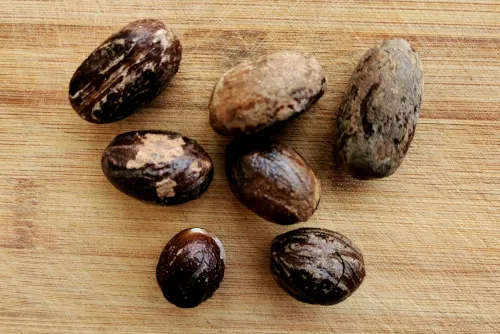
白寇 Amomum cardamomum
This spice is also called white cardamom. It is also not widely available outside China. I live in Malaysia with a large Chinese community and can get both ‘cardamoms’ at a Chinese grocery store near me. Some Chinese medical stores also keep these spices as it is used in traditional medicine. You can also get it online.
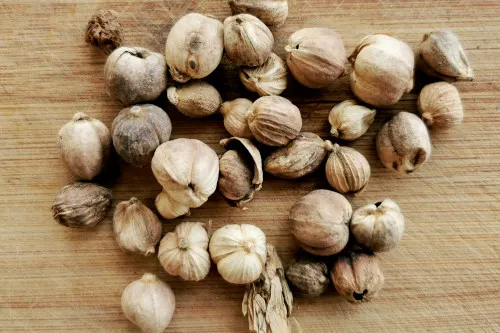
花椒 Szechuan peppercorns
There are two common types of Szechuan peppercorns – the red and the green. You can use either one in the Chinese hot pot recipe, but the green one has a more powerful tongue-numbing effect.
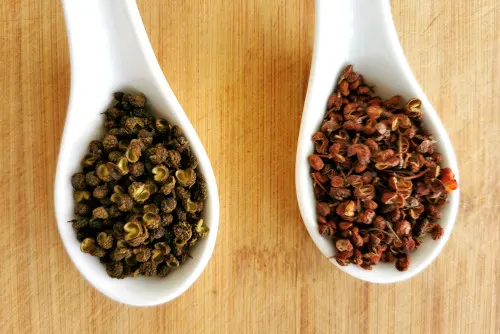
Cumin and fennel seeds
Cumin seeds are used in almost all Chinese spicy hot pot recipes. Some of them also include fennel seeds. It is up to you to decide which one to use, or both.
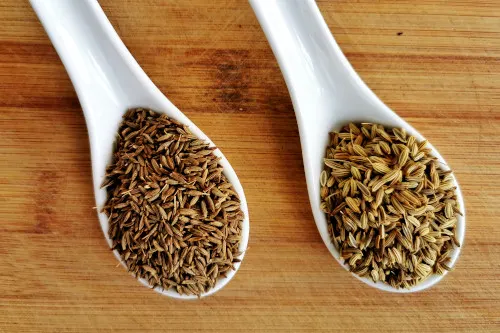
5. The Cantonese style herbal soup base (non-spicy)
The second type of Chinese hot pot soup base is the age-old recipe of my family. This soup base is the modified version of the Cantonese herbal soup.
I use the chicken and pork bones stock as the base and add the following Chinese herbs to simmer for an hour. (The goji berries are added much later as it takes a shorter time to release the flavor.) Season with salt, and it is ready.
All the herbs I used are readily available in the Chinese medical shop as they are commonly used in Chinese soups.
Here is a brief description of the herbs:
Dong Gui (Chinese Angelica, 当归) is sweet and slightly bitter. It has an unmistakably distinctive aroma, which can smell from far while boiling in the soup.
Yu zhu (Fragrant Solomonseal Rhizome /玉竹) has a pleasant and sweet taste. It balances the slight bitterness of dong gui.
Goji berry (Barbary Wolfberry Fruit / 枸杞子) has a sweet and neutral taste.
Red dates are soft on the outside, with a sweet smell.
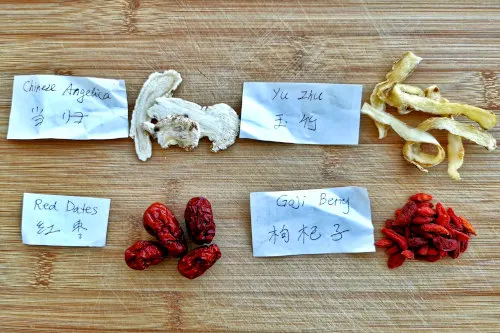
These herbs have health benefits but are also incredibly flavorful. It will certainly elevate any basic soup to the next level, and the flavor matches with any foodstuffs that you cook in the hot pot.
6. The essential hot pot equipment
Here is the essential equipment you need to serve the Chinese hot pot.
A portable stove. Since Chinese hot pot is served on the dining table or in an outdoor environment, a portable stove is required to keep the soup base at a constant boil. You can use an electric hot pot or a portable butane burner with any pot that fits.
A straining ladle (skimmer) is useful for nestling any food morsels to poach in the broth and retrieve it easily once cooked.
7. The popular food cooked in the hot pot
The types of food for the Chinese hot pot vary considerably between regions. The following items are my favorite and also the common combination at the hot pot restaurants near me. Ultimately, you should select your set of food based on your preference.
Below are the guidelines to decide the choice of food and soup base, which I hope is useful to you.
- It is a good idea to prepare one spicy and one clear soup for the diner to choose. The Szechuan spicy and the Cantonese herbal soup base in this post are a great combination. Another popular spicy soup base is Tom Yam soup. As for the non-spicy one, tomato base and miso soup are also my favorite.
- Any food should be small, preferably bite-size, which can be cooked within a short time because everyone shares the same pot.
- It is best to have a balance of meat, seafood, vegetables, and noodles, although the menu is deeply personalized.
- Since the list of food items is quite extensive (the idea is to have many varieties), it is almost impossible to make everything from scratch. I usually buy some items and make some myself. Variety is critical for the food platter, with a little bit of everything for the diner to choose.
Start with some vegetables
Napa cabbage is the first item I add to the soup base to give it some vegetable flavor. It also takes time to cook and wouldn’t be too soft after prolonged simmering.
Other favorite vegetables are carrot, sweetcorn, and daikon (radish). They all add flavors and can withstand prolonged boiling.
Follow by the main items
Now we can slowly add the meat and seafood. I would suggest buying thinly sliced meat (beef, lamb) from the store’s frozen section because they are sliced with a machine down to paper-thin. This thinly sliced meat is ready to eat within a minute in the simmering broth. It is unnecessary to marinate the meat (although there is no harm) since it is served with a flavored soup base.
I also suggest removing the meat before adding other seafood if the pot is small. Try to add the food items of the same size so that they will be cook simultaneously.
Some of the popular items are freshly sliced fish fillet, shrimp, cuttlefish, fish balls, fish cakes, and stuffed bitter gourd.
Mushrooms are the regular items on the hot pot menu. The popular types of mushrooms are Chinese dried mushrooms (must be presoaked), enoki, shiitake, button, and straw mushrooms.
Other items include various types of wontons and dumplings, firm tofu, and deep-fried bean curd skin 腐竹.
Although offal remains the classic hot pot ingredients, I leave it out as I don’t quite like it.
Finish with more vegetables and noodles
As time goes by, the amount of broth will gradually be reduced and the flavor is getting more intense. You can add some stock or water to dilute the broth.
You may cook the remaining vegetables and wrap up the hot pot feast with noodles. My recommendation is either rice vermicelli 米粉,glass noodles 冬粉 or Yi Mein 伊面 a type of deep-fried Cantonese noodles.
8. The dipping sauce
It is ideal to have dips and condiments on the side.
There is an excellent collection of dipping sauce for your selection in a hot pot restaurant. Some restaurants even offer a do-it-yourself sauce bar for diners to mix any ingredients of their choice.
At home, you can use some store-bought sauces like shacha sauce 沙茶醬 (Made with soybean oil, garlic, shallots, chilis, and dried shrimp), or the Szechuan chili sauce (for example, the Lao Gan Ma brand). Below are some combinations if you want to make your own.
- Chili flakes + soy sauce + black vinegar + coriander leaves
- Sesame oil + chopped scallions + chopped garlic + chili oil + black vinegar
- Oyster sauce + soy sauce + chopped garlic + sesame seeds + scallions
9. Other related recipes to Chinese hot pot (steamboat)
Here are some of the recipes on this blog that will catch your attention if you like the Chinese hot pot.
Chinese dumplings are the perfect ingredients for the Chinese hot pot. Making Chinese dumplings is a custom in China during the New Year when all the family members will take up their respective roles.
Nian gao is the must-have dessert during Chinese New Year. It is a delicacy that symbolizes prosperity and is most appropriate to serve during this auspicious festival
Buddha’s delight is the vegetarian dish cooked with fermented beancurd, leafy vegetables, and mushrooms. It is served on the first day of the new year since many Chinese prefer to be a vegetarian for that day.
10. The Chinese hot pot recipe
Chinese hot pot
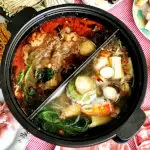
Chinese hot pot is a popular cooking style that involves everyone cooking their food in a shared pot of broth.
Ingredients
Ingredients for the stock (A)
- 1 chicken carcass
- 1 kg pork bones
- 10 slices ginger
- 3 stalks scallions, cut into sections
Ingredients for the non-spicy soup base (B)
- 1000ml soup stock A
- 2 pcs dong quai
- 2 red dates
- 10 pcs yu zhu
- 1 tbsp goji berries
- 1 clove garlic
- 1.5 tbsp salt
Ingredients for the Szechuan spicy soup base (C)
- 40 g dried chili, cut into short sections
- Aromatics:
- 10g of ginger, cut into slices
- 4 cloves of garlic
- 1 stalk of scallion, cut into sections
- 2 stalks of coriander leaves, cut into sections
- Spices:
- 1 star-anise
- 5cm cinnamon bark
- 1 Tsaoko
- 5 white cardamom
- 1 bay leaf
- 1/2 tsp cumin seeds
- 10 cloves
- 1.5 tsp green Szechuan peppercorns
- Others:
- 25g chili bean paste
- 5g rock sugar
- 1 tbsp Shaoxing wine
- 5g salt
- 1000ml soup stock A
Instructions
The pork and chicken stock:
- Clean the chicken and pork bones under running water several times.
- Place the bones in a pot of cold water and bring it to a boil.
- After two to three minutes, discard the dirty water, and wash the bones.
- Place the pork bones in a pot of cold water. Bring it to a boil.
- Simmer the pork bones with the scallions and ginger at barely simmering temperature for two hours.
- After two hours, add the chicken bones and simmer for another one hour.
- Remove the bones. Pour the stock through a wire mesh strainer to remove any small bones and debris.
The non-spicy soup base:
- Add all the herbs in B to the stock (except goji berries) and let it simmer for an hour.
- Add the goji berries before serve. Season with salt.
The spicy soup base:
- Soak the dry chilies with hot water for 30 minutes. Blend it to become a paste.
- Prepare the spice blend by coarsely ground the spices with the grinder.
- Heat the oil in a wok. Add the aromatics and fry over medium heat until fragrant. Remove the aromatics.
- Add the chili paste into the oil over medium heat to stir fry until the water has evaporated and become fragrant.
- Add the spices and the chili bean paste.
- Add a handful of additional dried chili. (optional)
- Add the rock sugar to balance the flavor and some rice wine.
- Pour the homemade stock into the pot and mix well, then season with salt.
- Bring it to a boil, and it's done.
Recommended Products
As an Amazon Associate and member of other affiliate programs, I earn from qualifying purchases.
Nutrition Information:
Yield:
4Serving Size:
1Amount Per Serving: Calories: 1059Total Fat: 48gSaturated Fat: 16gTrans Fat: 0gUnsaturated Fat: 27gCholesterol: 265mgSodium: 4634mgCarbohydrates: 62gFiber: 8gSugar: 17gProtein: 92g
This data was provided and calculated by Nutritionix on 2/5/2021

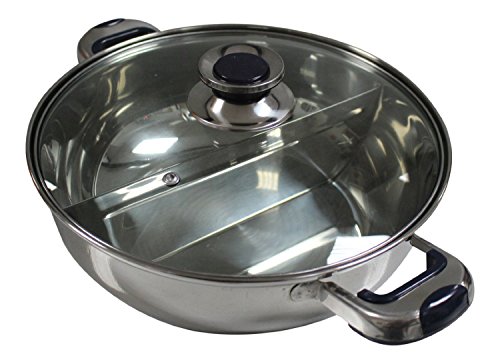



KP Kwan
Friday 5th of February 2021
Hi, this is KP Kwan. I am happy to see you in this comment area, as you have read through my recipe. I am pleased to reply to any questions and comments as soon as possible.